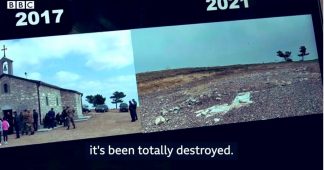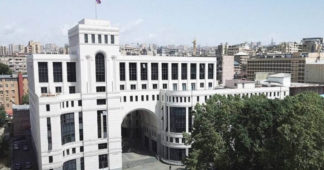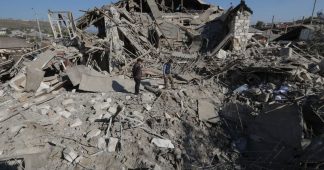The minister of culture said that a working group will be set up to identify what he called “Armenian forgery” from churches, putting into practice a pseudoscientific theory that denies the churches’ Armenian origin.
Feb 4, 2022
Azerbaijan’s government has announced that it intends to erase Armenian inscriptions on religious sites in the territory that it reclaimed in the 2020 war with Armenia.
It justified the move by arguing that the churches in fact were originally the heritage of Caucasian Albania, an ancient kingdom once located in what is now Azerbaijan. The theory, which is not supported by mainstream historians, has long been propagated by nationalist Azerbaijani historians and has been embraced by the current government in Baku.
Minister of Culture Anar Karimov told a press briefing on February 3 that a working group has been established which will be responsible for removing “the fictitious traces written by Armenians on Albanian religious temples.”
“We are going to inspect those places with the working group members, and after the inspection, we will consider our next steps,” Karimov said. While he did not identify who will be in the working group, the minister stated that the group will consist of “both local and international experts.”
The Albanian theory was first developed in the 1950s by prominent Azerbaijani historian Ziya Buniyatov, who claimed that Armenian inscriptions in churches on Azerbaijani territory were later additions to Albanian churches. According to this theory, they were only “Armenianized” following large-scale Armenian emigration to the region after Russia won control of the territory from Azerbaijan in the beginning of the 19th century.
The theory has gained momentum following the 2020 war, when Azerbaijan regained control of territory that contained several significant medieval Armenian churches.
In March 2021, on a trip to Hadrut, President Ilham Aliyev, together with his wife and daughter, visited a 12th-century Armenian Holy Mother of God Church, which was in ruins. “Armenians wanted to Armenianize this church and wrote inscriptions in Armenian here, but they failed. If this were an Armenian church, would they leave it in such a state? It looks as if it were a garbage dump,” Aliyev said at the church. “All these inscriptions are fake – they were written later.”
The day after the ceasefire was signed ending the 2020 war, Karimov tweeted about the medieval Armenian Dadivank Monastery in Azerbaijan’s Kelbajar district, calling it by the Azerbaijani name Khudavang and describing it as “one of the best testimonies of ancient Caucasian Albania civilization.”
In May 2021, a 19th-century church in the city of Shusha that had been damaged in the war started to undergo reconstruction, to what Baku said was its “original” form.
Meanwhile, Azerbaijan also has been promising to restore Azerbaijani monuments in the territory that had been neglected or vandalized during the years of Armenian occupation. In one case, Aliyev promised to restore a 19th century mosque which Armenians had presented as Persian rather than Azerbaijani.
But the announcement of the working group is the first concrete step that the government has taken overtly promising to erase Armenian traces on the churches now under their control.
“Usually even when they restore or renovate historic sites, we only become aware of what they have done afterwards,” Javid Agha, a social media commentator who has extensively researched Albanian heritage in Azerbaijan, told Eurasianet.
Agha drew a comparison with Julfa, in Azerbaijan’s Nakhchivan, where thousands of Armenian “khachkar” cross stones were destroyed in 2005.
The ongoing threats to Armenian cultural sites have drawn international concern. Shortly after the war, Aliyev promised Russian President Vladimir Putin that he would protect Christian sites in the newly retaken territories. UNESCO issued a statement warning Armenia and Azerbaijan that “damage to cultural property belonging to any people whatsoever means damage to the cultural heritage of all mankind.” Efforts by UNESCO to send a mission to Karabakh to examine the cultural heritage sites have long been stalled, however.
In December, the International Court of Justice (ICJ) ruled that Azerbaijan must “take all necessary measures to prevent and punish acts of vandalism and desecration affecting Armenian cultural heritage, including but not limited to churches and other places of worship, monuments, landmarks, cemeteries and artifacts.”
“If this is true, they are blatantly violating the [ICJ] order,” Sheila Paylan, a legal adviser to Armenia for the ICJ case, told Eurasianet. “For the future of this case, it certainly doesn’t help Azerbaijan’s position that they are in full respect of the obligation to prevent desecration. This constitutes an active measure to falsify and destroy Armenian cultural heritage.”
Armenian officials did not immediately react to the Azerbaijani announcement. Ministry of Foreign Affairs spokesperson Vahan Hunanyan told Eurasianet that they had no comment on this specific issue now but that they had repeatedly emphasized the importance of preserving Armenian cultural heritage.
We remind our readers that publication of articles on our site does not mean that we agree with what is written. Our policy is to publish anything which we consider of interest, so as to assist our readers in forming their opinions. Sometimes we even publish articles with which we totally disagree, since we believe it is important for our readers to be informed on as wide a spectrum of views as possible.











